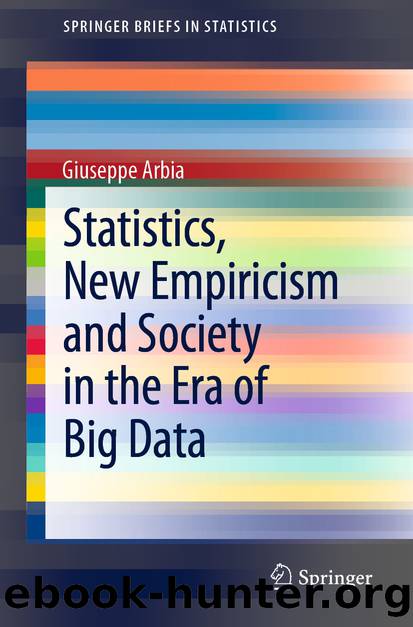Statistics, New Empiricism and Society in the Era of Big Data by Giuseppe Arbia

Author:Giuseppe Arbia
Language: eng
Format: epub
ISBN: 9783030730307
Publisher: Springer International Publishing
Despite the fact that the newspaper printed as its headline âDewey defeats Trumanâ crediting Gallupâs forecasts, the man in the picture was indeed Harry Truman and his satisfied expression is more than justified by the fact that the forecasts were wrong. Gallup believed the error was mostly due to the fact that his sample observations ended three weeks before elections and he missed a number of electors that changed their minds in the last two weeks, but there was much more in it.
What happened was that Gallupâs predictions were mostly based on a sample of individuals that were contacted through the telephone. Even if it is difficult to believe now especially for the younger people, at the time only a few people had a private telephone at home19 and they were, not surprisingly, the wealthier individuals that could afford an instrument that at the time was still quite expansive. Therefore, Gallup was not observing an objective picture of reality. By cancelling a priori the possibility of observing people without a telephone, he was over-sampling wealthier people and, in contrast, under-sampling poorer individuals. He was thus violating the condition of equal chance of being drawn which is, as we said before, one important characteristic required by statistical theory to have reliable sample observations. Wealthier people at the time were more incline to vote for T. E. Dewey, and for this reason, Gallup was sampling mostly from the population of Deweyâs supporters and the result was then obvious. Collecting data through the telephone was a convenient way of gathering quickly sample information, but it was not a rigorous statistical sample and, as such, was not useful for drawing theoretically grounded inductive inference on the future electoral results.
Similar errors were repeated more recently by American pollsters. In the 2016 presidential elections, most of the pollsters were predicting a large success of Hillary D. Clinton, a prediction that turns out to be wrong with the final success of Donald J. Trump. This was considered by someone as a big failure of statistics that shed a negative light on the actual possibility of using samples in order to anticipate electoral results.
What happened in that case was that predictions were based on samples drawn from a list of those that were classified as the likely voters. Such a list could be compiled long before the elections because a likely voter is defined as someone who decided to take part in the last three presidential elections, that is, in the last 12 years. However, in 2016, there was a big change in the attitude of potential electors with over 7 million voters more than those in 2012. On that occasion, the percentage of voting-eligible population increased from 54.9 to 59.2%. Furthermore, many of those that didnât decide to vote in the past were attracted by the figure of Donald Trump and decided to participate in the 2016 election. In contrast, many electors that had been assiduous voters in the past (mainly democrats) decided to desert the polls.
Download
This site does not store any files on its server. We only index and link to content provided by other sites. Please contact the content providers to delete copyright contents if any and email us, we'll remove relevant links or contents immediately.
Modelling of Convective Heat and Mass Transfer in Rotating Flows by Igor V. Shevchuk(6391)
Weapons of Math Destruction by Cathy O'Neil(6148)
Factfulness: Ten Reasons We're Wrong About the World – and Why Things Are Better Than You Think by Hans Rosling(4694)
Descartes' Error by Antonio Damasio(3231)
A Mind For Numbers: How to Excel at Math and Science (Even If You Flunked Algebra) by Barbara Oakley(3221)
Factfulness_Ten Reasons We're Wrong About the World_and Why Things Are Better Than You Think by Hans Rosling(3199)
TCP IP by Todd Lammle(3136)
Fooled by Randomness: The Hidden Role of Chance in Life and in the Markets by Nassim Nicholas Taleb(3048)
Applied Predictive Modeling by Max Kuhn & Kjell Johnson(3019)
The Tyranny of Metrics by Jerry Z. Muller(3003)
The Book of Numbers by Peter Bentley(2912)
The Great Unknown by Marcus du Sautoy(2648)
Once Upon an Algorithm by Martin Erwig(2599)
Easy Algebra Step-by-Step by Sandra Luna McCune(2585)
Lady Luck by Kristen Ashley(2534)
Practical Guide To Principal Component Methods in R (Multivariate Analysis Book 2) by Alboukadel Kassambara(2497)
Police Exams Prep 2018-2019 by Kaplan Test Prep(2487)
All Things Reconsidered by Bill Thompson III(2357)
Linear Time-Invariant Systems, Behaviors and Modules by Ulrich Oberst & Martin Scheicher & Ingrid Scheicher(2334)
